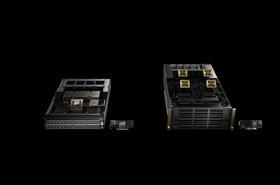The era of high demand is here. Growing workloads in AI, cloud computing, and streaming have created a huge demand for data center compute capacity.
Operators are racing to meet this demand, but to do so, they must figure out how to extend the life of data centers to be more adaptable to changing workloads.
To keep pace, data centers must become more flexible, which will require the more regular replacement of data center hardware. This requires a new kind of modularity – data centers that are designed with flexibility and interchangeability from the outset. This is where cabling becomes critical. Badly thought-through cabling can prevent operators from easily swapping out hardware, resulting in costly downtime.
To become more flexible, modularity is needed – but not as we know it. And cabling will become more important than ever.
The threefold challenge
New technology trends can drive significant new demand – the journey from the Edge to the Internet of Things and now AI has presented a major challenge for operators. This is evident in rack power and density trends. Rack power densities have risen from 4-5kW over a decade ago, to 8-10kW in 2020. It’s also predicted that AI will mean operators need to install infrastructure that can accommodate 50 – 100kW per rack.
To accommodate these trends in power and rack density, operators will need to conduct more rapid hardware refreshes to adopt GPU-powered racks. But operators will face three key challenges – the surge in the need for AI-related data center capacity, a slowdown in construction, and the extended operational lifespan of hardware.
As these challenges persist, data center operators need to implement more frequent and rapid hardware refreshes, specifically to integrate GPU-powered racks.
This will require operators to rethink data center design and prioritize adaptability. This shift extends beyond immediate scalability concerns, such as aligning with sustainability goals to foster greener and more efficient data centers.
To proactively address issues hindering interchangeability – such as bad cabling, poor installation, and resource shortages – operators need to embrace a new kind of modularity. Failure to do so will put new or existing data centers at increased risk of falling into disarray and requiring early refreshes.
The cabling and modularity link
This new approach means embracing a new kind of modularity, a concept the data center industry has flirted with for some time.
Traditionally, modularity has referred to building data centers from prefabricated modules that included everything from power to cooling. The idea was that this would result in sites that are quicker to build, but it didn’t always help operators to scale.
Modularity as a containerized concept isn’t always enough to meet the explosive demand and workloads facing operators. However, the underlying principle is critical to navigating the challenges of more frequent hardware refreshes.
Modularity must no longer be just about “Lego brick” containers. It’s about building modular IT infrastructure where interchangeability and connectivity are key. This makes plug-and-play hardware a reality.
Cabling will become a critical foundation that facilitates flexibility in modular data centers. Bad cabling can cause poor connectivity, data corruption, and troubleshooting issues – all leading to downtime. Replacing it is costly compared to best-practice installation. What’s more, bad cabling could potentially shorten a data center’s lifespan from 10–15 years to just three. For modularity to become a reality, cabling must become a much more important aspect of design.
The cabling playbook
Building modular data centers will become increasingly necessary as AI workloads ramp up. The key to success will be in adopting a holistic approach to planning, and ensuring cabling best practices are followed. This includes:
- Shifting the mindset to modular: Operators should view sites as integrated engineering purpose-built projects rather than conventional commercial developments. cooling, and network routing dependencies.
- Being more strategic about cabling: Benchmark and minimize the number of high-quality cabling suppliers chosen for consistent, standardized architecture. Carefully limiting suppliers facilitates support, leverages economies of scale, and ensures tight alignment for efficient inventory management.
- Building a skills pipeline: Foster a diverse skillset pipeline, including technical, installation, and maintenance competencies. Develop local talent to enhance data center sustainability and agility for efficient project delivery. Anticipate future needs through AI, analytics, and predictive skills, while collaborating with educational institutions for workforce development.
- Developing a blueprint for cabling strategy: Create a detailed cabling project plan prior to installation. This must factor in the data center’s unique requirements, cable lengths, cable trays, preparation time, and delivery schedules to ensure precise infrastructure design without delays.
- Creating a meticulous installation guide: Create a clear installation guide detailing cable types, connections, compatibility, measurements, and patch cabling. This guide will be a working plan for modular data centers, facilitating seamless hardware interchange.
Unraveling the crucial role of cabling
To become more flexible, data centers must rethink their definition of modularity. As AI and other workloads continue to increase and accelerate, data centers can keep pace by adopting modular IT infrastructure where interchangeability and connectivity are foundational.
By adhering to cabling best practices, operators can effortlessly upgrade hardware, enabling them to provide AI-compute solutions and seamlessly accommodate evolving workloads.





